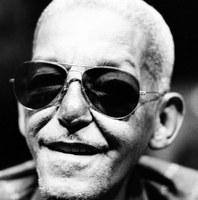Rio de Janeiro (Brazil), 1908 – 1980
By Marcelo Silva Souza
 Life in the Mangueira hill in the city of Rio de Janeiro was the primary source of inspiration for the songs that made Angenor Oliveira, known as Cartola, one of the greatest composers and performers of Brazilian music. Like many other poor and popular artists, this self-taught songwriter’s story is marked by material fragility and creative strength.
Life in the Mangueira hill in the city of Rio de Janeiro was the primary source of inspiration for the songs that made Angenor Oliveira, known as Cartola, one of the greatest composers and performers of Brazilian music. Like many other poor and popular artists, this self-taught songwriter’s story is marked by material fragility and creative strength.
From a young age, he participated in street festivals, following in his father’s footsteps on the cavaquinho and guitar, the instrument he would primarily use for composing his songs. After his mother died when he was fifteen, he dropped out of school and started doing odd jobs to make a living. In fact, he received the nickname that would go down in Brazilian music history because of the top hat he wore to protect himself from the sun while working as a painter and bricklayer.
At the age of twenty, he was one of the founders, along with his most faithful musical partner, Carlos Cachaça, of the second samba school in Rio de Janeiro, which would become one of the most famous: the Grêmio Recreativo Escola de Samba Estação Primeira da Mangueira.
In 1931, the famous singer Mário Reis went up the hill to buy one of his songs. Ironically, he sold the samba “Que infeliz sorte” for a good sum, which ended up being recorded by Francisco Alves, “the singer of the masses.” Thus, without realizing it, Cartola became part of Brazil’s emerging recording industry in the wake of the 1930 Revolution. The buy-sell scene would repeat itself in the following years, and Cartola’s sambas would become increasingly well-known.
Through Pixinguinha, in 1940, he was invited by Heitor Villa-Lobos to join the group of musicians who would record popular songs aboard the ship Uruguai, with the aim of promoting Brazilian music in the United States. On that occasion, Cartola recorded one of his most important sambas, “Quem me vê sorrindo.”
But after the recording, he went through a disturbing period: he fell seriously ill, his wife passed away, and he left the hill. Believing that he too had died, some even dedicated songs to him. This could well have been the end of Cartola’s career, had it not been for one of those chance encounters that forever change the history of music. In 1956, the chronicler Sérgio Porto (Stanislaw Ponte Preta) found Cartola washing cars in Ipanema, the beautiful neighborhood of Rio de Janeiro. Sérgio then brought him to sing on the radio and got him a job at a newspaper.
In the early 1950s, Cartola returned to the Mangueira hill and began living with Eusébia Silva do Nascimento (Dona Zica), also a widow, whom he married in 1964. With her, he opened the Zicartola restaurant in 1963, a launch pad for future masters like Paulinho da Viola and a place that promoted integration between the left-wing bossa nova artists—who were then beginning to split—and the artists from the hill, or simply between the “sambas from the asphalt” and the “sambas from the hill.”
The “samba troubadour” composed around five hundred songs but only had time to record four solo albums. The first of them, *Cartola*, was produced by the well-known researcher and producer Marcus Pereira in 1974. Despite the few albums, the innovative interpretation of his music and the refinement he acquired over the years, expressed in songs that perfectly blend lyrics and melody, such as “Acontece,” “Cordas de aço,” and “Alvorada,” made those records a unique contribution to the history of Brazilian music. Another anthological work is the album *Fala Mangueira*, produced in 1968 by Hermínio Belo de Carvalho, in which Cartola sings alongside Nelson Cavaquinho, Carlos Cachaça, Clementina de Jesus, and Odete Amaral.
In the mid-1970s, while working as a public servant, Cartola and Dona Zica moved to a small house they managed to build in Jacarepaguá. In 1980, Cartola died of cancer. At his funeral, a small crowd sang the beautiful samba-canción “As rosas não falam,” accompanied by the Mangueira drummer, Waldomiro, as the Mangueira master had requested. Cartola will also be remembered for the classic songs “O mundo é um moinho” and “O inverno de meu tempo.”
**Content updated on 04/07/2017 16:46**


